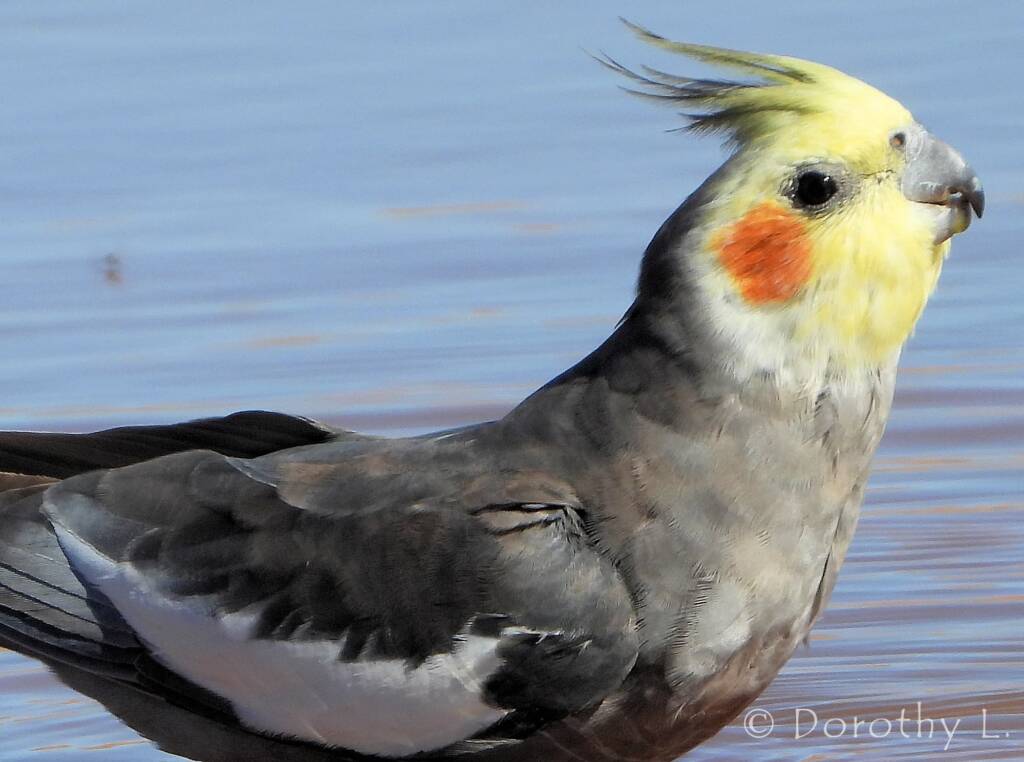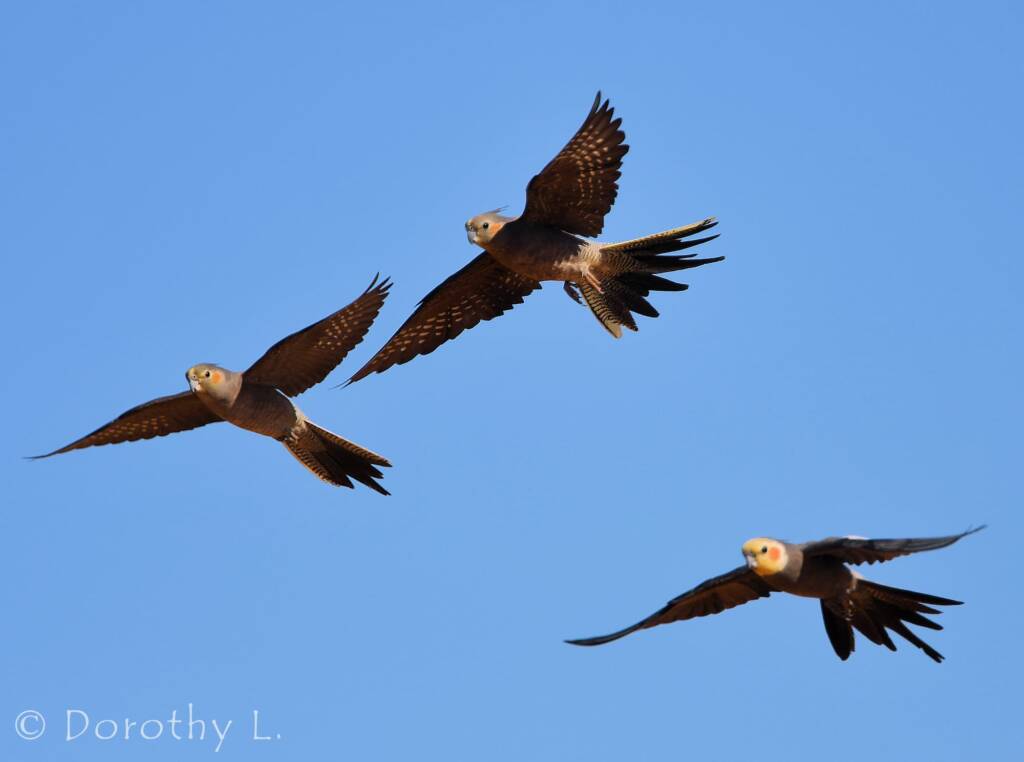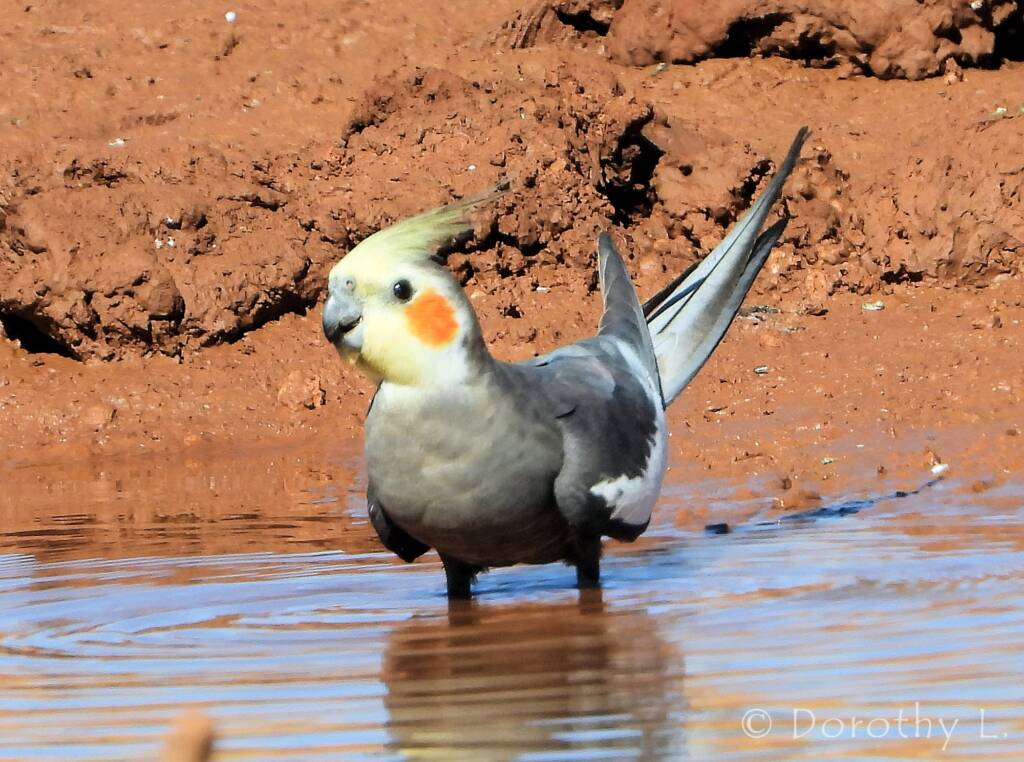CockatielCockatiels – flight Cockatiels – resting & roosting Cockatiels – water
The Cockatiel (Nymphicus hollandicus) is a small parrot endemic to Australia. The only member of the genus Nymphicus, it is the smallest of the family Cacatuidae (cockatoo family).

The Cockatiel has a slender body and long tail feathers, roughly making up half of its total length. In the wild the cockatiel’s plumage is primarily grey with prominent white flashes on the outer edges of each wing. The male of the species is identified by its bright yellow forehead, face and crest, while the face of the female is primarily grey to light grey. Both sexes feature a round orange area on both ears, which is usually vibrant in adult males and muted in females. Young cockatiels are similar to the adult female, although the young males usually have a brighter yellow face.

The cockatiel shares the cockatoo family’s biological features, including the erectile crest, a gallbladder, powder down, suppressed cloudy-layer (which precludes the display of blue and green structural colours), and facial feathers covering the sides of the beak, all of which are rarely found outside the family Cacatuidae.

It is the distinctive pointed crest that gives an insight into the emotional state of this parrot. When the cockatiel is startled or excited, the crest is dramatically vertical. When relaxed, the crest is in a oblique position, as opposed to flat close to the head when the bird is defensive or angry. When flirtatious and amorous, the crest is held flat, but protruding outward in the back. When tired, the cockatiel crest is positioned halfway upwards, with the crest tip curling upward.1


The mature adult cockatiels are sexually dimorphic that is only evident after the first moulting, around about six to nine months after hatching. The male of the species lose the white or yellow barring and spots on the underside of his tail feathers and wings. The grey feathers on his cheeks and crest are replaced by bright yellow feathers, whilst the orange cheek patch becomes brighter and more distinct. The female of the species remain grey on the face and crest, with the orange cheek patch. The female retains the horizontal barring on the underside of her tail feathers.

The juvenile cockatiels are similar in colour to the female, until their first moulting. The juvenile display horizontal yellow stripes or bars on the ventral surface of their tail feathers and yellow spots on the ventral surface of the primary flight feathers of their wings. Similar to the female they have the grey coloured crest and face, and a dull orange patch on their cheeks.

The Cockatiel are found mainly in the inland regions of Australia, preferring areas of open country, including scrub and bush lands, especially where it can forage on the ground. As with many birds of the inland regions, Cockatiel are influenced by rainfall, during which time they breed up in good numbers, then during subsequent drought periods, move to regions where they do not normally occur.
Common name
Cockatiel, Weiro Bird, Quarrio.

Like many birds, they are striking in flight. Seeing them flying through the air like a volley of arrows, the wild Cockatiels can reach speeds of 64 km per hour.

- Scientific classification
- Kingdom: Animalia
- Phylum: Chordata
- Class: Aves
- Order: Psittaciformes
- Family: Cacatuidae
- Subfamily: Nymphicinae
- Genus: Nymphicus
- Species: N. hollandicus
- Binomial name: Nymphicus hollandicus

Footnote & References
- Cockatiel, https://en.wikipedia.org/wiki/Cockatiel (last visited Sept. 20, 2021)
- Cockatiel, BirdLife Australia, https://birdlife.org.au/bird-profile/cockatiel
CockatielCockatiels – flight Cockatiels – resting & roosting Cockatiels – water
ParrotsAustralian Ringnecks Bluebonnet Bourke’s Parrot Budgerigar Cockatiel Galah Major Mitchell’s Cockatoo Mallee Ringneck Mulga Parrot Port Lincoln Ringneck Purple-crowned Lorikeet Rainbow Lorikeet Red-collared Lorikeet Red-tailed Black Cockatoo Sulphur-crested Cockatoo Yellow-tailed Black Cockatoo
BirdsApostlebird Australasian Darter Australasian Figbird Australasian Gannet Australasian Grebe Australasian Pipit Australasian Robins Australasian Shoveler (Spatula rhynchotis) Australasian Wrens Australian Babblers Australian Bustard Australian Chats Australian Magpie Australian Pelican Australian Pratincole (Stiltia isabella) Australian White Ibis Bassian Thrush Black-faced Cormorant Black-faced Woodswallow Black Swan Bowerbirds Brolga Brown Songlark Channel-billed Cuckoo Cinnamon Quail-thrush Cormorants Cuckooshrikes and Allies Dotterels Lapwings Plovers Doves & Pigeons Emu Fairy Martin Finches Grey Fantail Grey Teal Honeyeaters Kingfishers Little Friarbird Little Grassbird Magpie-lark Masked Woodswallow Noisy Pitta Olive Whistler Paradise Riflebird Pardalotes Parrots Pheasant Coucal Pied Butcherbird Rainbow Bee-eater Raptors Rufous Fantail Redthroat Rufous Bristlebird Silver-crowned Friarbird Torresian Crow Waders Welcome Swallow (Hirundo neoxena) Whiskered Tern (Chlidonias hybrida) White-browed Woodswallow White Capped Noddy White-faced Heron White-necked Heron Willie Wagtail Yellow-throated Scrubwren
